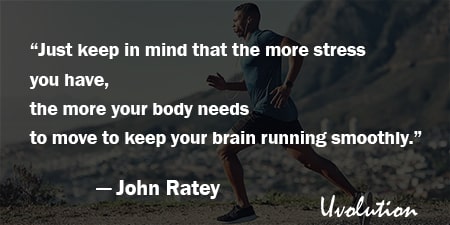Spark by John Ratey Summary
The Book in 1 Sentences
Spark: The Revolutionary New Science of Exercise and the Brain
“To keep our brains at peak performance, our bodies need to work hard. In Spark, I’ll demonstrate how and why physical activity is crucial to the way we think and feel.
I’ll explain the science of how exercise cues the building blocks of learning in the brain; how it affects mood, anxiety, and attention; how it guards against stress and reverses some of the effects of aging in the brain; and how in women it can help stave off the sometimes tumultuous effects of hormonal changes.
I’m not talking about the fuzzy notion of runner’s high. I’m not talking about a notion at all. These are tangible changes, measured in lab rats and identified in people.” ~ John Ratey
9 BIG Ideas
1. Transforming Students’ Bodies Made Them Smarter!
2. Exercise, Literacy Class, and Work!
3. Exercise Improves Cognitive Flexibility
5. Exercise Reestablishes Connections Between Brain Cells
6. Exercise Changes Your Risk for Depression
7. Exercise Vs. Antidepressants Experiment
Spark Book Summary
1. Transforming Students’ Bodies Made Them Smarter!
“In Naperville, Illinois, gym class has transformed the student body of nineteen thousand into perhaps the fittest in the nation. Among one entire class of sophomores, only 3 percent were overweight, versus the national average of 30 percent.
What’s more surprising — stunning — is that the program has also turned those students into some of the smartest in the nation.
In 1999 Naperville’s eighth graders were among some 230,000 students from around the world who took an international standards test called TIMSS (Trends in International Mathematics and Science Study), which evaluates knowledge of math and science.
In recent years, students in China, Japan, and Singapore have outpaced American kids in these crucial subjects, but Naperville is the conspicuous exception: when its students took the TIMSS, they finished sixth in math and first in the world in science.
As politicians and pundits sound the alarm about faltering education in the United States, and about our students being ill-equipped to succeed in today’s technologydriven economy, Naperville stands out as an extraordinary bit of good news.”
“In 2001 fit kids scored twice as well on academic tests as their unfit peers.”
2. Exercise, Literacy Class, and Work!
“The administration is so impressed that it incorporates Zero Hour into the high school curriculum as a first-period literacy class called Learning Readiness PE. And the experiment continues.
The literacy students are split into two classes: one second period, when they’re still feeling the effects of the exercise, and one eighth period. As expected, the second-period literacy class performs best.
The strategy spreads beyond freshmen who need to boost their reading scores, and guidance counselors begin suggesting that all students schedule their hardest subjects immediately after gym, to capitalize on the beneficial effects of exercise. It’s a truly revolutionary concept from which we can all learn.”
Ratey puts it this way: “If you had half an hour of exercise this morning, you’re in the right frame of mind to sit still and focus on this paragraph, and your brain is far more equipped to remember it.”
3. Exercise Improves Cognitive Flexibility
“A notable experiment in 2007 showed that cognitive flexibility improves after just one thirty-five-minute treadmill session at either 60 percent or 70 percent of maximum heart rate.
The forty adults in the study (age fifty to sixty-four) were asked to rattle off alternative uses for common objects, like a newspaper — it’s meant for reading, but it can be used to wrap fish, line a birdcage, pack dishes, and so forth.
Half of them watched a movie and the other half exercised, and they were tested before the session, immediately after, and again twenty minutes later.
The movie watchers showed no change, but the runners improved their processing speed and cognitive flexibility after just one workout.
Cognitive flexibility is an important executive function that reflects our ability to shift thinking and to produce a steady flow of creative thoughts and answers as opposed to a regurgitation of the usual responses.
The trait correlates with high-performance levels in intellectually demanding jobs.
So if you have an important afternoon brainstorming session scheduled, going for a short, intense run during lunchtime is a smart idea.”
Ratey says: “What we now know is that the brain is flexible, or plastic in the parlance of neuroscientists — more Play-Doh than porcelain. It is an adaptable organ that can be molded by input in much the same way as a muscle can be sculpted by lifting barbells. The more you use it, the stronger and more flexible it becomes.”
4. Ancestors’ Routine!
“The human body is built for regular physical activity, but how much? In a 2002 article in the Journal of Applied Physiology, researchers studied this very question, by looking at our ancestors’ pattern of physical activity, which they call the Paleolithic rhythm.
From the time Homo sapiens emerged two million years ago, until the agricultural revolution, ten thousand years ago, everyone was a hunter-gatherer, and life was marked by periods of intense physical activity followed by days of rest. It was feast or famine.
By calculating how much our forebears “exercised” and comparing it to figures from today, it’s easy to see where the problem lies: Our average energy expenditure per unit of body mass is less than 38 percent of that of our Stone Age ancestors.
And I think it’s fair to say that our calorie intake has increased quite a bit. The kicker is that even if we followed the most demanding governmental recommendations for exercise and logged thirty minutes of physical activity a day, we’d still be at less than half the energy expenditure for which our genes are encoded. Paleolithic man had to walk five to ten miles on an average day, just to be able to eat.”
Ratey also says: “Today, of course, there’s no need to forage and hunt to survive. Yet our genes are coded for this activity, and our brains are meant to direct it. Take that activity away, and you’re disrupting a delicate biological balance that has been fine-tuned over half a million years.
Quite simply, we need to engage our endurance metabolism to keep our bodies and brains in optimum condition. The ancient rhythms of activity ingrained in our DNA translate roughly to the varied intensity of walking, jogging, running, and sprinting.
In broad strokes, then, I think the best advice is to follow our ancestors’ routine: walk or jog every day, run a couple of times a week, and then go for the kill every now and then by sprinting.”
5. Exercise Reestablishes Connections Between Brain Cells
“According to the World Health Organization, depression is the leading cause of disability in the United States and Canada, ahead of coronary heart disease, any given cancer, and AIDS. About 17 percent of American adults experience depression at some point in their lives, to the tune of $26.1 billion in health care costs each year.”
“Everything we do and think and feel is governed by how our brain cells, or neurons, connect to one another. What most people think of as psychological makeup is rooted in the biology of these connections.”
And the good news “Overall, I think of depression as an erosion of connections — in your life as well as between your brain cells. Exercise reestablishes those connections.”
Did you know that “The brain responds like muscles do, growing with use, withering with inactivity. The neurons in the brain connect to one another through “leaves” on treelike branches, and exercise causes those branches to grow and bloom with new buds, thus enhancing brain function at a fundamental level.”
6. Exercise Changes Your Risk for Depression
“One of the best examples is a landmark research project from the Human Population Laboratory in Berkeley called the Alameda County Study. Researchers tracked 8,023 people for twenty-six years, surveying them about a number of factors related to lifestyle habits and healthiness starting in 1965.
They checked back in with the participants in 1974 and in 1983. Of all the people with no signs of depression at the beginning, those who became inactive over the next nine years were 1.5 times more likely to have depression by 1983 than their active counterparts.
On the other hand, those who were inactive to begin with but increased their level of activity by the first interval were no more likely to be depressed by 1983 than those who were active to begin with.
In other words, changing your exercise habits changes your risk for depression.”
And “Exercise has a profound impact on cognitive abilities and mental health. It is simply one of the best treatments we have for most psychiatric problems.”
Ratey tells us “Just keep in mind that the more stress you have, the more your body needs to move to keep your brain running smoothly.”
7. Exercise Vs. Antidepressants Experiment
“We’ve known for a while that exercise influences the same chemicals as antidepressants do, but nobody had done a scientifically sound head-to-head comparison until researchers at Duke University took up the task in 1999.
In a landmark study affectionately called SMILE (Standard Medical Intervention and Long-term Exercise), James Blumenthal and his colleagues pitted exercise against the SSRI sertraline (Zoloft) in a sixteen-week trial.
They randomly divided 156 patients into three groups: Zoloft, exercise, or a combination of the two.
The exercise group was assigned to supervised walking or jogging, at 70 to 85 percent of their aerobic capacity, for thirty minutes (not including a ten-minute warm-up and a five-minute cool-down) three times a week.
The results? All three groups showed a significant drop in depression, and about half of each group was completely out of the woods — in remission. Another 13 percent experienced fewer symptoms but didn’t fully recover.”
Ratey also says: “If everyone knew that exercise worked as well as Zoloft, I think we could put a real dent in the disease.”
Sonja Lyubomirsky’s – in her book The How of Happiness - refers to the study and says: “No one in our society needs to be told that exercise is good for us. Whether you are overweight or have a chronic illness or are a slim couch potato, you’ve probably heard or read this dictum countless times throughout your life.
But has anyone told you— indeed, guaranteed you—that regular physical activity will make you happier? I swear by it.”
Dr. Walter M. Bortz – in his book Dare to Be 100 – also says: “The tremendous value that physical exercise provides to your body is established beyond any reasonable doubt. Dr. Bob Butler said, “If there was a drug that provided all the benefits that exercise does, the whole world would be taking it.”
Of course, there is no such drug; the value of exercise must come from an activity program of your own devising and accomplishment. You cannot delegate exercise, and you can’t get something for nothing.”
Ratey advices us: “If you have a tendency toward addictive behavior it’s vital to develop some sort of consistent exercise habit.”
And he also says: “I tell people that going for a run is like taking a little bit of Prozac and a little bit of Ritalin because, like the drugs, exercise elevates these neurotransmitters. It’s a handy metaphor to get the point across, but the deeper explanation is that exercise balances neurotransmitters — along with the rest of the neurochemicals in the brain. And as you’ll see, keeping your brain in balance can change your life.”
8. A Little is Good, and More is Better
“Duscha is an expert in cardiovascular health, but he says the same thing almost every neuroscientist cited in these pages has said: “A little is good, and more is better.”
The best, however, based on everything I’ve read and seen, would be to do some form of aerobic activity six days a week, for forty-five minutes to an hour.
Four of those days should be on the longer side, at moderate intensity, and two on the shorter side, at high intensity.
And while there’s conflicting evidence about whether high-intensity activity, which can force your body into anaerobic metabolism, impacts thinking and mood, it clearly releases some of the important growth factors from the body that build up the brain.
So, on the shorter, high-intensity days, include some form of strength or resistance training. These days should not be back to back; your body and brain need recovery time to grow after high-intensity days.
In total, I’m talking about committing six hours a week to your brain. That works out to 5 percent of your waking hours.”
“Aerobic activity has a dramatic effect on adaptation, regulating systems that might be out of balance and optimizing those that are not — it’s an indispensable tool for anyone who wants to reach his or her full potential.”
9. Just Start (Even Walking!)
Ratey continues: “That said, I do agree with experts like Duscha that the most important thing is to do something. And to start. This last bit may sound obvious, but for the sedentary — especially if inactivity is due to depression — taking that first step may seem impossible.
For some people it’s a catch-22: they can’t start because they don’t have the energy, and they don’t have the energy because they’re not exercising.
I’ve seen this happen with some of my patients, and it’s a very real problem, not simply an issue of willpower. The key is to attack the business of starting as a challenge in itself.”
Dan Millman – in his book Body Mind Mastery - says: “Remember that vigor and vitality is a matter of activity, not necessarily formal exercise. I’m always amazed to see cars driving around and around, looking for the closest space to the health club so they can get on a treadmill and walk three miles!
Park the car at the farthest point from the store. Use the stairs instead of the escalator or elevator. Carry your groceries, garden, and do other activities that keep you moving. You will add more years to your life and more life to your years.”
Ratey also advices us: “If you haven’t been active, I think the best way to begin is to start walking. Take the stairs instead of the elevator, park at the back of the lot, and go for a stroll around the block at lunchtime.”
“We’re taking our cues from neuroscience and our inspiration from all the people who have already seen what exercise can do for their brains.
My hope is that everything I’ve laid out in these pages will encourage you to grab your gym bag instead of the remote, or spend time on the field rather than on the sidelines.
From your genes to your emotions, your body and brain are dying to embrace the physical life. You are built to move. When you do, you’ll be on fire.”
And always remember that “You have the power to change your brain. All you have to do is lace up your running shoes.”
That was my QUICK summary of the great book Spark by John Ratey. If you’re interested, get your copy. There is a HUGE amount of wisdom and life-changing ideas in this book, and we’ve only touched on a tiny bit of it.
Buy The Book: Spark by John Ratey

GET Blinkist 7 Days FREE Trial
3000+ Book Summaries
(Audio and Text)





